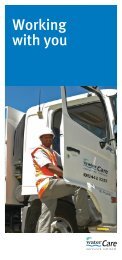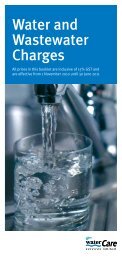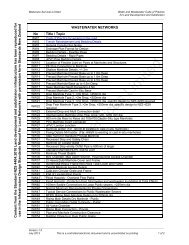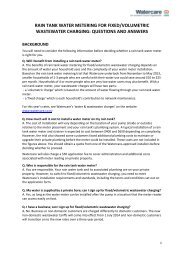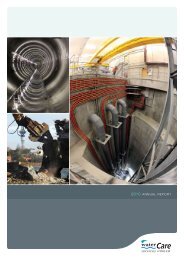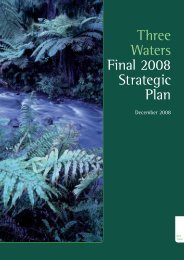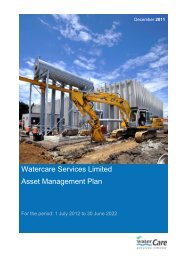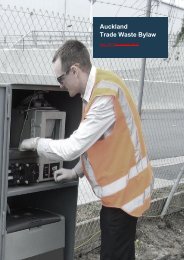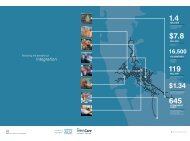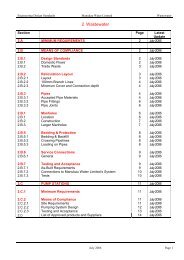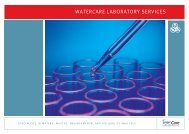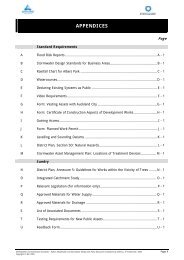Annual Report 2011 - Watercare
Annual Report 2011 - Watercare
Annual Report 2011 - Watercare
Create successful ePaper yourself
Turn your PDF publications into a flip-book with our unique Google optimized e-Paper software.
<strong>Watercare</strong> Services Limited<br />
<strong>2011</strong> ANNUAL REPORT<br />
STATEMENT OF ACCOUNTING POLICIES (continued)<br />
FOR THE YEAR ENDED 30 JUNE <strong>2011</strong><br />
11. Property, Plant and Equipment<br />
Classes of assets<br />
Property, plant and equipment is allocated to classes, being:<br />
• Land (including improvements)<br />
• Buildings<br />
• Pipelines<br />
• Tanks, tunnels, roads and reservoirs<br />
• Dams<br />
• Machinery<br />
• Motor vehicles<br />
• Office equipment<br />
• Work in progress<br />
Initial recognition<br />
The cost of purchased property, plant and equipment is the initial purchase price plus directly attributable costs of bringing the assets to the<br />
location and condition necessary for their intended use.<br />
Constructed assets are initially recorded as work in progress at the cost of construction (including materials and direct labour), finance costs and<br />
other direct costs until the asset is ready for productive use. Finance costs incurred during the course of construction that are attributable to a<br />
project are capitalised, using the finance rate applicable to the funding. When the asset is ready for productive use the ongoing operating and<br />
finance costs are recorded as expenses.<br />
Subsequent recognition<br />
Land and buildings are carried at fair values that reflect current market values, which is the amount that would be expected from an orderly sale,<br />
determined by an independent registered valuer at least every three years.<br />
Pipelines, tanks, tunnels, roads, reservoirs, dams and machinery are also carried at fair value, which is deemed to be depreciated replacement<br />
cost because the assets are of a specialised nature. The depreciated replacement costs are determined on the basis of an independent valuation<br />
prepared by external valuers at least every three years. The revaluation process involves assessing the current replacement cost and remaining<br />
useful lives of the specialised property, plant and equipment.<br />
Any property, plant and equipment that has been acquired after the most recent valuation is carried at cost less accumulated depreciation and<br />
impairment until the next revaluation.<br />
Motor vehicles and office equipment are carried at cost less accumulated depreciation. Work in progress is carried at cost.<br />
The changes in the value of each class of property, plant and equipment as a result of the revaluations are recorded in other comprehensive<br />
income and accumulated in a revaluation reserve. The group maintains a revaluation reserve for each class of assets. Where cumulative decreases<br />
exceed cumulative increases in the value of a class of assets, the net amount is recognised as an expense in determining the surplus or deficit for<br />
the year. Any revaluation increase is credited to the asset class revaluation reserve, except to the extent that it reverses a revaluation decrease for<br />
the same asset previously charged as an expense in determining the surplus or deficit for the year. Any accumulated depreciation at the date of<br />
the revaluation is transferred to the gross carrying amount of the asset and the asset cost is restated to the revalued amount.<br />
<strong>2011</strong> Financial <strong>Report</strong><br />
Impairment<br />
Asset carrying values are reviewed for impairment whenever events or changes in circumstances indicate the carrying amount may not be<br />
recoverable. An impairment loss is recognised if the estimated recoverable amount of an asset is less than its carrying amount. The recoverable<br />
amount is the higher of an asset’s fair value less costs to sell and value in use. For revalued assets, value in use is the depreciated replacement<br />
cost for an asset, where the future economic benefits of the asset are not primarily dependent on the asset’s ability to generate net cash inflows,<br />
and where the entity would, if deprived of the asset, replace its remaining future economic benefits. The value in use for cash-generating assets<br />
is the present value of expected future cash flows. If an asset’s carrying amount exceeds its recoverable amount, the asset is impaired and the<br />
carrying amount is written down to the recoverable amount.<br />
For revalued assets, the impairment loss is recognised in other comprehensive income to the extent that the impairment loss does not exceed the<br />
amount in the revaluation surplus for that same class of asset. The reversal of an impairment loss on a revalued asset is credited to the revaluation<br />
reserve. However, to the extent that an impairment loss on the same class of asset was previously recognised within surplus or deficit, a reversal<br />
of that impairment loss is also recognised within surplus or deficit. For assets not carried at a revalued amount the total impairment loss and the<br />
reversal of an impairment loss (for assets other than goodwill) is recognised in the surplus or deficit.<br />
PAGE 76<br />
Return to Contents page



